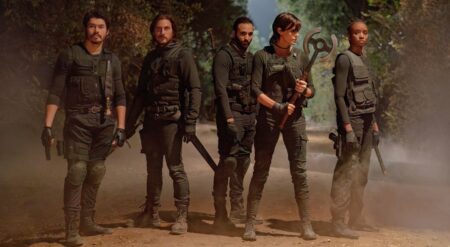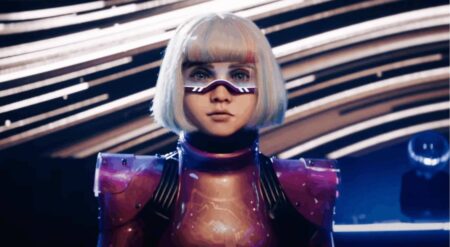Kingdom of the Planet of the Apes is a visually masterful, rollicking adventure that indicates the saga of the Planet of the Apes is far from over. In 2017, Matt Reeves (The Batman) ended the reboot trilogy of 1968’s Planet of the Apes on a high note with War for the Planet of the Apes. The trilogy following the simultaneous rise of intelligent chimpanzee Caesar (Andy Serkis) and the downfall of humanity brought new acclaim to the long-running franchise.
Now, Wes Ball of The Maze Runner trilogy fame is here to take up the Herculean task of following up Caesar’s story. More or less, he gets the job done—and does it well. Set 300 years after War For Planet of the Apes, Kingdom of the Planet of the Apes centers on chimpanzee Noa (Owen Teague), a young hunter in a community of evolved apes. As he prepares for a ceremony sacred to his people, a rival civilization kidnaps the members of his village.
Under the tutelage of loner orangutan Raka (Peter Macon), helped by resourceful human Mae (Freya Allan), Noa comes face to face with authoritarian ape leader Proximus Caesar (Kevin Durand). Hoarding ape communities to build up his civilization, Proximus is on the verge of a discovery that could change the fate of humans and apes forever.
Kingdom of the Planet of the Apes gets off to a rocky start. Although easy to like in a broad sense, Noa and his friends Soona (Lydia Peckham) and Anaya (Travis Jeffrey) don’t have the instant endearment of Andy Serkis’ Caesar. The goings-on of Noa’s village aren’t as fascinating as Wes Ball thinks they are. Instead, the opening 20 minutes or so of Kingdom of the Planet of the Apes feels like an obligatory table setting.
Who said table setting couldn’t be pretty, though?

Beyond a shadow of a doubt, Kingdom of the Planet of the Apes is the best-looking Apes movie yet. Shot primarily on location by cinematographer Gyula Pados, the landscapes on display are gorgeous. Decrepit city-scapes look more like a big-budget The Last of Us adaptation than the actual The Last of Us adaptation. Overgrown moss and trees overtake the towering skyscrapers. The once markers of prosperity have turned into a literal urban jungle.
Moreover, the ape characters are rendered at an impressive crossroads of evolution. Not quite fully humanoid, not quite primates, Ball embraces the uncanny valley and renders these creatures in as much detail as possible. You can see every emotion in Noa’s eyes. Even strings of saliva are visible as he opens his mouth. The team behind this film isn’t content with repeating the same tricks of War for the Planet of the Apes.
The same sentiment goes for the storyline. Lest the marketing fool the audience, this is undoubtedly a sequel to the prior films dealing with Caesar’s legacy. There are those like Raka, who steal every scene he’s in, who still uphold Caesar’s teachings against the passage of time. On the other hand, there are those like Proximus Caesar, in a very loud, bombastic Kevin Durand performance, who have perverted Caesar’s iconography to their own image.
Proximus Caesar’s damn near post-apocalyptic lair, complete with a dam holding back the ocean and an abandoned ship, is like something out of the Mad Max franchise. By that comparison, I’m specifically referring to Proximus’ kingdom recalling a ramshackle facsimile of an old-world place of order now harboring sinister ideologies.

A big worry going into Kingdom of the Planet of the Apes was that it would continue to further de-center the social commentary that’s been so vital to the series since its inception. Thankfully, that’s not the case. Wes Ball wants us to think about the growing dichotomy between humans and apes. Through the character of Mae, the question is raised as to whether it’s our place to stand in the way of revolution, even if it means our own detriment.
William H. Macy’s character raises the question of whether inaction and complacency are more dangerous. The side that Kingdom screenwriter Josh Friedman comes down on is that in an ongoing revolution, distinct choices must be made. Whether those are the right choices or not, only history will decide. But who gets to shepherd that history- people like Raka or Proximus?
As a brief aside, there are several pieces of connective tissue here that appear to lead back to the 1968 Planet of the Apes. If these are breadcrumbs and not just Easter eggs for the fans, then this project being a prequel of sorts could make it even more satisfying. If not, then it’s still a very worthwhile project.
It’s clear that long-time series writers/producers Rick Jaffa and Amanda Silver were around to keep this ship going in the right direction. Kingdom of the Planet of the Apes doesn’t reach the stratospheric heights of the original film or the prior trilogy, but it is a thoughtful, exciting, majorly accomplished visual work that will continue to raise the profile of the franchise. As Caesar’s followers would say: “Apes Together Strong,” and if talented creatives continue to put in the work, this franchise will continue to be strong.
Watch Kingdom of the Planet of the Apes in theaters May 10, 2024.
Are We So Back With Kingdom of the Planet of the Apes!? | Review
This week we dive into Kingdom of the Planet of the Apes – set generations after the events of 2017’s War for Planet of the Apes, Kingdom embraces Caesar’s Trilogy but sets its own path. It embraces characters and revels in the environment. Are we back boys?
Kingdom of the Planet of the Apes
-
Rating - 8/108/10
TL;DR
Kingdom of the Planet of the Apes doesn’t reach the stratospheric heights of the original film or the prior trilogy, but it is a thoughtful, exciting, majorly accomplished visual work that will continue to raise the profile of the franchise.







